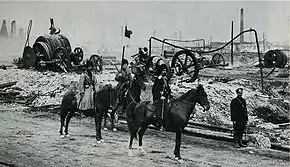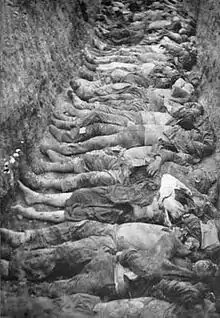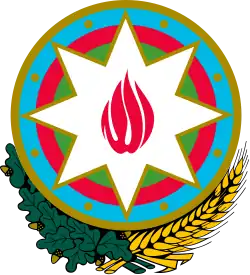Armenian–Tatar massacres of 1905–07
The Armenian–Tatar massacres (also known as the Armenian-Tartar war, the Armeno-Tartar war and, more recently, the Armenian-Azeri War[2]) refers to the bloody inter-ethnic confrontation between Armenians and the populations which would later comprise the nation of Azerbaijan (at the time commonly known as "Caucasian Tatars" or "Tatars of the Caucasus")[3][4] throughout the Russian Caucasus in 1905–1907.[5][6][7]
| Armenian–Tatar massacres | ||||||||
|---|---|---|---|---|---|---|---|---|
| Part of Revolution of 1905 | ||||||||
 A Cossack military patrol near the Baku oilfields, ca. 1905. | ||||||||
| ||||||||
| Belligerents | ||||||||
|
Armenian groups | Caucasian Muslim groups[1] |
| ||||||
The massacres started during the Russian Revolution of 1905, and claimed hundreds of lives. The most violent clashes occurred in 1905 in February in Baku, in May in Nakhchivan, in August in Shusha and in November in Elizavetopol, heavily damaging the cities and the Baku oilfields. Some violence, although of lesser scale, broke out also in Tbilisi.
The clashes were not confined to the towns, and, according to Swietochowski, citing Armenian sources 128 Armenian and 158 Caucasian Tatar villages were destroyed or pillaged,[8] while the overall estimates of lives lost vary widely, ranging from 3,000 to 10,000, with Caucasian Tatars suffering higher losses,[9] which stemmed from Tatar mobs being organized poorly and Dashnaks on the Armenian side being more effective.[10]
In Baku
_victim_in_Baku.jpg.webp)
According to Van Der Leeuw, clashes started in early February 1905 over the killing of a Tatar schoolboy and shopkeeper by Armenians.[11] 126 Tatars and 218 Armenians were killed during four days of fighting in Baku.[11] Other sources such as Dasnabedian, Luigi Villari or Walker claim that Tatars had started the conflict which provided the Armenian community a reason to give a strong response; Tatars in Baku had killed numerous unarmed Armenians in February 1905.[12] Walker also said that, "Tatars were free to massacre with impunity".[11]
According to the Baku Statistical Bureau and statements provided in Saint Petersburg, 205 Armenians were killed, which included 7 women, 20 children, and 13 elderly, along with 121 wounded; 111 Tartars were additionally killed, consisting of 2 women and no children or elderly, as well as 128 injured.[13]
In Nakhichevan and Shusha

After the Baku clashes, Muslim communities in the Nakhichevan district began smuggling consignments of weapons from Persia. By April, murders of Armenians in the district began to assume alarming proportions and the Armenian community applied to the Russian authorities for protection. However, Luigi Villari describes the district's governor as "bitterly anti-Armenian" and the vice-governor in Yerevan as an "Armenophobe".[14]
On 25 May, acting on a previously arranged plan, bands of armed Tartars attacked the market area in the district capital, the town of Nakhichevan, looting and burning Armenian businesses and killing any Armenians they could find. Approximately 50 Armenians were murdered and some of the shopkeepers were burnt alive in their shops. The same day, Tartar villagers from the countryside began attacking their Armenian neighbours. Villari cites official reports mentioning that "out of a total of 52 villages with Armenian or mixed Armenian-Tartar populations, 47 were attacked, and of that 47, 19 were completely destroyed and abandoned by their inhabitants. The total number of dead, including those in Nakchivan town, was 239. Later, in a revenge attack, Armenians attacked a Tartar village, killing 36 people".[15]
Concerning the situation in Shusha, according to Thomas de Waal, "the number of killed and wounded amounted to about 300, of whom about two-thirds were Tartars, for the Armenians were better shots and also enjoyed the advantage of position."[16]
In Ganja
Prior to the Armenian-Tatar massacres, Ganja had a sizable Armenian population.[17][18] Among the Armenians, the city is known as Gandzak (Գանձակ)[19][20][21] The name Gandzak derives from gandz (Arm. - գանձ), the loan word from Old Iranian, which means treasure or riches.[22][23]
Responsibility
According to professor Firuz Kazemzadeh, "it is impossible to pin the blame for the massacres on either side. It seems that in some cases (Baku, Elizavetpol) the Tatars fired the first shots, in other cases (Shusha, Tiflis) the Armenians."[24]
References
Notes
- BUTCHERY IN THE CAUCASUS.; A State of Civil War -- 30,000 Combatants of Various Races The New York Times
- Nicholas W. Miller. Nagorno-Karabakh: A War without Peace. Kristen Eichensehr (ed.), W. Michael Reisman (ed.) Stopping Wars and Making Peace: Studies in International Intervention. Martinus Nijhoff Publishers, 2009
- Suha Bolukbasi. Nation-building in Azerbaijan. Willem van Schendel (ed.), Erik Jan Zürcher (ed.). Identity politics in Central Asia and the Muslim world. I.B.Tauris, 2001. "Until the 1905—6 Armeno-Tatar (the Azeris were called Tatars by Russia) war, localism was the main tenet of cultural identity among Azeri intellectuals."
- Joseph Russell Rudolph. Hot spot: North America and Europe. ABC-CLIO, 2008. "To these larger moments can be added dozens of lesser ones, such as the 1905-06 Armenian-Tartar wars that gave Azeris and Armenians an opportunity to kill one another in the areas of Armenia and Azerbaijan that were then controlled by Russia..."
- Britannica Online Encyclopedia. Azerbaijan. History.
- Brockhaus and Efron Encyclopedic Dictionary. Turks
- Willem van Schendel, Erik Jan Zürcher. Identity Politics in Central Asia and the Muslim World: Nationalism, Ethnicity and Labour in the Twentieth Century. I.B.Tauris, 2001. ISBN 1-86064-261-6, ISBN 978-1-86064-261-6, p. 43
- Cornell, Svante. Small Nations and Great Powers: A Study of Ethnopolitical Conflict in the Caucasus, p. 69.
- Tadeusz Swietochowski. Russia and Azerbaijan: A Borderland in Transition. Columbia University Press, 1995. ISBN 0-231-07068-3, ISBN 978-0-231-07068-3
- Cornell, Svante. Small Nations and Great Powers: A Study of Ethnopolitical Conflict in the Caucasus, p. 56.
- Svante E. Cornell. Small nations and great powers. page 55
- Luigi Villari. Fire and Sword in the Caucasus: ″The authorities were perpetually telling the Tartars that the Armenians were meditating a massacre of Mussulmans, and that they should be on the qui vive... and on the 19th of February they proceeded to massacre every Armenian they came across. The Armenians defended themselves as best they could, but the Tartars were much more numerous and better armed.″
- Saint-Peterburg Vedomosti, 25 May 1905
- Villari, Luigi. Fire and Sword in the Caucasus. London: T. F. Unwin, 1906 ISBN 0-7007-1624-6 p. 270.
- Villari, Luigi. Fire and Sword in the Caucasus. London: T. F. Unwin, 1906 ISBN 0-7007-1624-6 p. 270-274.
- de Waal, Thomas (2003). Black Garden: Armenia and Azerbaijan Through Peace and War. New York: New York University Press. p. 190. ISBN 978-0-8147-1945-9.
- Soviet Census in 1926-1979, Newspaper Pravda Press, Moscow, 1983
- According to the 1892 official data, "10524 of 25758 inhabitants of the city were Armenians, there were 6 Armenian Apostolic (Gregorian) churches", Elizavetpol article, Brockauz and Efron Encyclopedia (in Russian)
- "the union of Georgian and Armenian armies near Gandzak", Great Soviet Encyclopedia (BSE)
- "Mkhitar Gosh was born in Gandzak", Mkhitar Gosh article, (BSE)
- "Gandzak (Ganja)" [jss.oxfordjournals.org/cgi/reprint/6/2/145.pdf The death of the last 'Abbasid Caliph': a contemporary Muslim account, by Boyle J. // Semitic Studies.1961; 6: 145-161
- Philological Society (Great Britain) (1956). Transactions of the Philological Society. Philological Society (Great Britain). Published for the Society by B. Blackwell. p. 100.
- Dictionary.Hayastan.com
- Firuz Kazemzadeh. Struggle For Transcaucasia (1917—1921), New York Philosophical Library, 1951
Bibliography
- Luigi Villari (1906), Fire and Sword in the Caucasus , London, T. F. Unwin, ISBN 0-7007-1624-6
- Thomas De Waal (2004), Black Garden: Armenia and Azerbaijan Through Peace and War, NYU Press, ISBN 978-0-8147-1945-9

